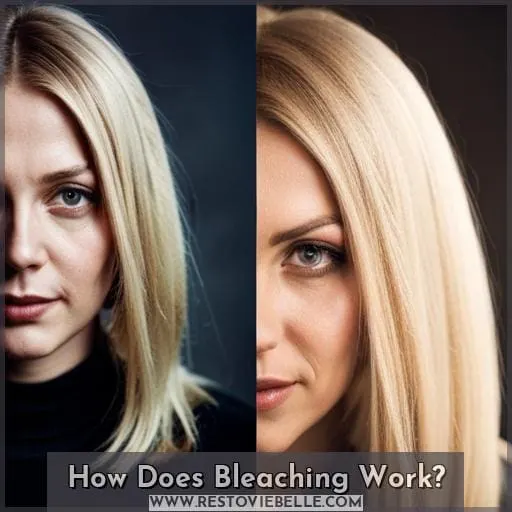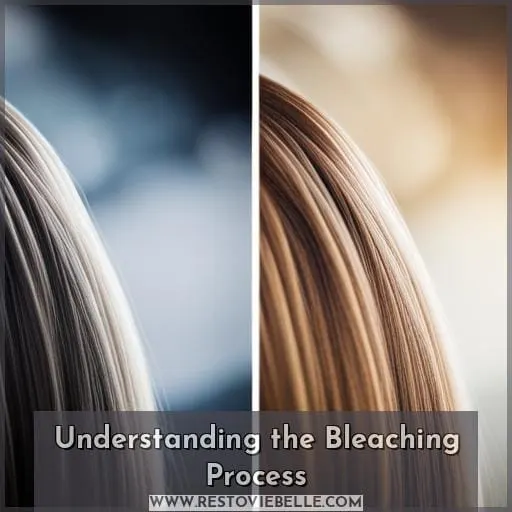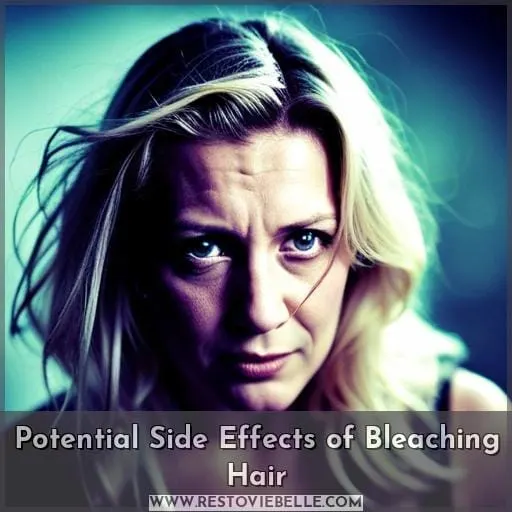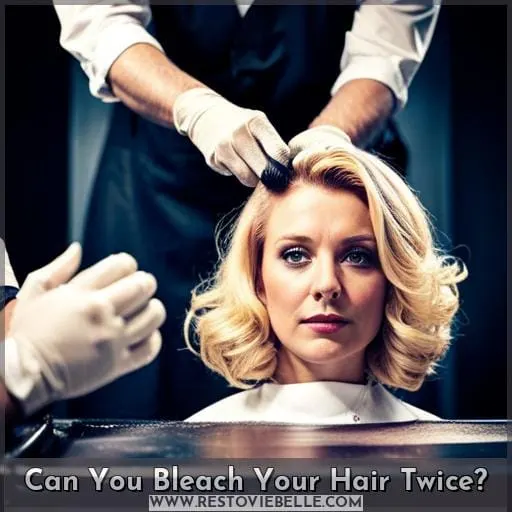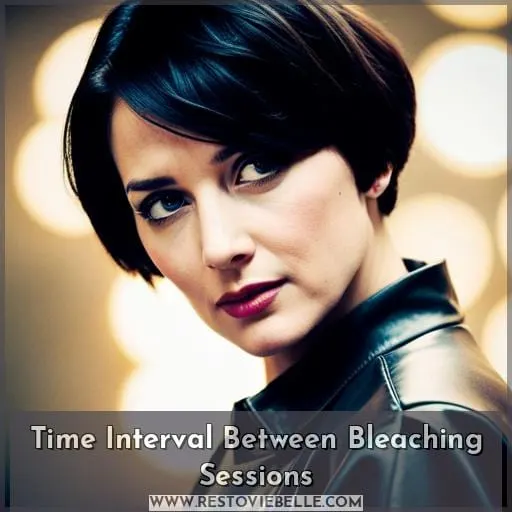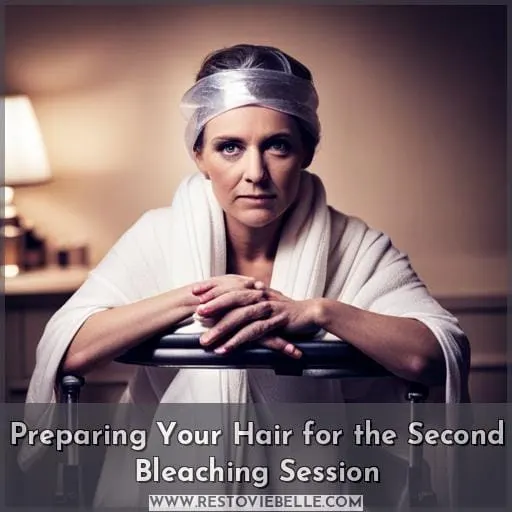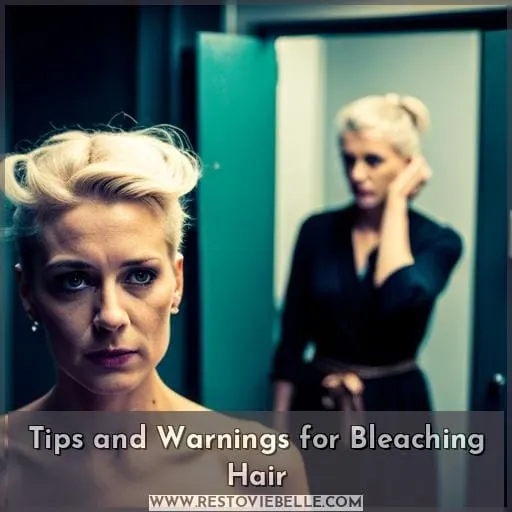This site is supported by our readers. We may earn a commission, at no cost to you, if you purchase through links.
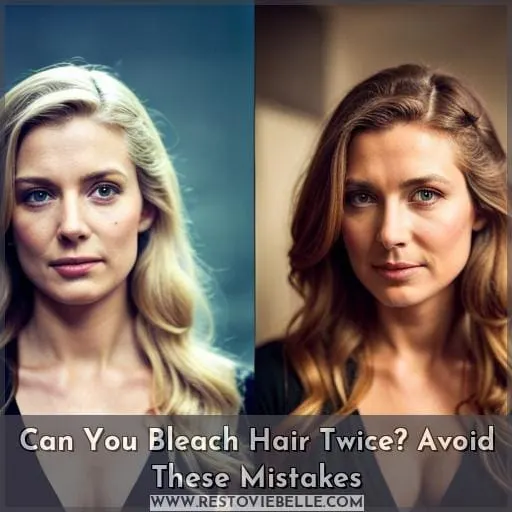 Curious if you can bleach hair twice? Discover the answer and avoid common mistakes in this informative article.
Curious if you can bleach hair twice? Discover the answer and avoid common mistakes in this informative article.
Bleaching works by oxidizing melanin pigments, lightening your hair’s color. However, repeated treatments with harsh chemicals like hydrogen peroxide and ammonia can damage your hair shafts.
Uncover the truth about double bleaching to ensure healthy and vibrant locks while achieving your desired look.
Table Of Contents
- Key Takeaways
- How Does Bleaching Work?
- Understanding the Bleaching Process
- Potential Side Effects of Bleaching Hair
- Can You Bleach Your Hair Twice?
- Time Interval Between Bleaching Sessions
- How Long Should You Wait to Bleach Your Hair Again?
- Preparing Your Hair for the Second Bleaching Session
- Tips and Warnings for Bleaching Hair
- Frequently Asked Questions (FAQs)
- What are the potential risks of wearing metal accessories during the bleaching process?
- How can improper mixing during the bleaching process result in hair discoloration?
- What steps can be taken to minimize the risk of hair breakage and loss when bleaching hair twice in a day?
- Are there any specific types of oil or conditioning treatments that are recommended during the waiting period between bleaching sessions?
- How long should one wait between bleaching sessions to ensure proper hair rest, rehydration, and recovery?
- Conclusion
Key Takeaways
- Bleaching hair twice can cause further damage and weaken the hair structure.
- It is important to prioritize hair recovery and health over excessive bleaching sessions.
- Waiting for 4 to 6 weeks between bleaching sessions is recommended to give the hair ample time to recover.
- Cleansing the hair thoroughly and conducting a strand test before the second bleach are important steps to prepare the hair.
How Does Bleaching Work?
To understand the process of bleaching, it’s important for you to know how this chemical treatment works.
Bleaching involves an oxidative process that targets hair melanin. Aggressive agents like hydrogen peroxide and ammonia are used to oxidize the natural color pigments in your hair, resulting in a lighter shade.
However, these chemicals can have adverse effects on your scalp and hair health. Ammonia can cause scalp sensitivity and burns while metal reactions may lead to discoloration or even breakage of your hair strands.
It’s crucial to be aware of these risks before undergoing any bleaching procedure.
After bleaching, proper care becomes essential for maintaining healthy-looking locks. Hydration is key as bleach tends to strip away moisture from your tresses, making them dry and brittle post-treatment.
Incorporating hydrating products into your routine such as deep conditioning treatments or leave-in conditioners can help restore moisture levels.
Overall, understanding how bleaching works allows you to make informed decisions about whether it’s suitable for you or not based on potential risks involved.
Understanding the Bleaching Process
To understand the bleaching process, it’s important to familiarize yourself with its steps and potential side effects.
Preparing for hair bleaching involves gathering essential supplies such as lightener, developer, and toner.
Performing a strand test beforehand can help determine how your hair will react to the bleach.
Preparing for Hair Bleaching
Before starting the bleaching process, gather all the necessary supplies and make sure you have a clear understanding of how hair bleaching works.
- Knowing how to protect your hair from damage
- Taking care of your scalp during the process
- Retaining moisture in your strands
- Being aware of chemical reactions that may occur
- Preparing for post-bleaching care
Taking these precautions will help ensure a successful and safe bleaching experience.
Essential Supplies for Bleaching
First, gather all the essential supplies you’ll need to properly bleach your hair.
Here is a table outlining the necessary items for successful bleaching:
| Supplies | Purpose |
|---|---|
| Bleach powder | Lightens hair color |
| Developer | Activates bleach |
| Toner | Corrects unwanted tones |
| Mixing bowl | Prepares bleach mixture |
Make sure to wear protective gear such as gloves and an apron during application.
After bleaching, follow a proper aftercare routine to protect and nourish your hair while also considering color correction if needed.
Performing a Strand Test
Now, let’s delve into the process of performing a strand test to better understand the bleaching process.
Strand testing is crucial for assessing the hair’s tolerance to bleach and predicting potential reactions. It allows you to gauge how your strands will react before applying bleach all over your head. This test also helps ensure accuracy in achieving your desired results while maintaining strand health.
The Bleaching Process
To understand the bleaching process thoroughly, let’s dive into how it actually works and what you need to know.
- Bleaching oxidizes hair melanin using aggressive agents like hydrogen peroxide and ammonia.
- Side effects include scalp burns, dryness, and potential hair discoloration.
- Proper moisture balance is crucial for damage prevention during bleaching.
- Post-bleach care involves scalp care, maintaining moisture balance, and promoting hair recovery.
Potential Side Effects of Bleaching Hair
When bleaching hair, it’s important to be aware of the potential side effects that may occur.
- Scalp sensitivity can lead to discomfort and even burns during the bleaching process.
- Hair porosity plays a role in how well your hair absorbs and reacts to bleach, with highly porous hair being more susceptible to damage.
- Chemical reactions between the bleach and other products can cause unwanted color correction or discoloration of your hair.
- Furthermore, excessive bleaching strips away moisture from your strands, disrupting their natural moisture balance and leaving them dry and brittle.
It’s crucial to consider these factors before deciding whether or not you should bleach your hair twice in order to avoid severe damage or breakage.
Can You Bleach Your Hair Twice?
If you’re considering bleaching your hair twice, it’s important to understand the potential risks and consequences involved.
Bleaching already puts immense stress on your hair, causing damage and weakening its structure. Subjecting your hair to a second round of bleach within a short time frame can lead to further harm that may be difficult to recover from.
Your priority should be focusing on hair recovery and health rather than pushing boundaries with excessive bleaching sessions.
To practice damage control after bleaching, it’s crucial to prioritize post-bleach care.
- Using nourishing treatments such as deep conditioning masks or oils regularly.
- Avoiding heat styling tools as much as possible.
- Minimizing chemical treatments like relaxing or perming for some time after the process.
- Ensuring optimal timing between each bleach session.
Remember that patience is key when it comes to taking care of chemically treated hair. Give yourself ample time for proper rejuvenation before attempting another round of bleaching.
Time Interval Between Bleaching Sessions
How long should you wait between bleaching sessions?
The time interval between bleaching sessions is crucial for the health and strength of your hair.
- Bleaching frequency: Avoid frequent bleaching as it can lead to severe damage and breakage. Give your hair ample time to recover before subjecting it to another round of bleach.
- Recovery period: It’s recommended to wait for 4 to 6 weeks before scheduling your next bleaching session. This allows your hair enough time for rest, rehydration, and recovery from the previous process.
- Hair hydration: During this waiting period, focus on hydrating treatments such as deep conditioning masks or oil treatments. Hydrated hair is more resilient against damage caused by subsequent bleach applications.
By following these guidelines, you can minimize potential harm while maintaining healthy locks during the post-bleach care phase.
How Long Should You Wait to Bleach Your Hair Again?
To maintain the health and integrity of your hair, it’s important to wait for a sufficient amount of time before bleaching it again.
- Optimal Waiting Time:
It’s recommended to wait at least 4 to 6 weeks between bleaching sessions. This allows your hair time to rest, rehydrate, and recover from the previous bleach treatment.
- Hair Recovery Strategies:
During this waiting period, focus on implementing effective hair recovery strategies such as applying nourishing oils or deep conditioning treatments regularly. These can help restore moisture and strengthen your strands.
- Post-Bleach Conditioning:
Prioritize post-bleach conditioning by using products specifically formulated for chemically treated hair. Look for ingredients like keratin or protein that can repair damage caused by bleaching.
Remember that each individual’s hair may have different needs and tolerances when it comes to bleach treatments. If in doubt, consult with a professional hairstylist who can assess your specific situation and provide expert guidance on timing and care routines for subsequent bleach sessions.
Preparing Your Hair for the Second Bleaching Session
Before embarking on your second bleaching session, there are several important steps you should take to prepare your hair.
First, consider consulting a professional to assess the health and condition of your hair.
Next, cleanse your hair thoroughly to remove any buildup or residue that may interfere with the bleaching process.
Follow up with a conditioning treatment to restore moisture and strengthen your strands.
Lastly, avoid chemical treatments in the weeks leading up to the second bleach and conduct a strand test beforehand for optimal results.
Consulting a Professional
Before proceeding with a second bleaching session, consult a professional hairstylist for expert guidance and preparation.
The cost of consultation is worth the benefits it provides – ensuring proper care and minimizing hair damage.
Finding a good consultant involves checking their expertise, reputation, and client reviews.
During the consultation, ask questions about recommended products or treatments specific to your hair type.
Expect personalized advice on preparing your hair for the second bleaching session to achieve desired results while minimizing potential risks.
Cleansing Your Hair
After consulting a professional, cleanse your hair thoroughly before proceeding with the second bleaching session.
- Use a clarifying shampoo to remove any product buildup.
- Avoid sulfates that can strip the hair of moisture.
- Rinse with lukewarm water instead of hot water to prevent further dryness.
- Deep condition your hair afterward to restore hydration and nourishment.
Properly cleansing and conditioning your hair will help minimize damage during the second bleaching process.
Conditioning Treatment
For your second bleaching session, prioritize a deep conditioning treatment for your hair.
This step is crucial to repair and restore the health of your hair after the damaging effects of bleach.
A conditioning treatment can be in the form of a mask or oil that nourishes and moisturizes your strands, preventing dryness and brittleness.
By incorporating this step into your routine, you’ll ensure that your hair stays strong and healthy throughout the bleaching process.
Avoiding Chemical Treatments
To prepare your hair for the second bleaching session, avoid any chemical treatments that may further damage your hair.
- Deep condition your hair using a nourishing mask to restore moisture and strengthen strands.
- Avoid using harsh chemicals such as dyes or relaxers that can weaken already delicate hair.
- Opt for natural remedies like coconut oil or a specialized serum to protect and hydrate your locks before proceeding with another round of bleaching.
Conducting a Strand Test
Before moving forward with your second bleaching session, conduct a strand test to assess the condition and readiness of your hair. This test helps determine how much bleach to use, how long to leave it on, and what results you can expect.
To perform the strand test:
| Amount of Bleach | Time Left On | Results |
|---|---|---|
| Small Amount | Few Min | Lightened Slightly |
By conducting a strand test, you can avoid potential damage by ensuring that your hair is ready for another round of bleaching.
Tips and Warnings for Bleaching Hair
When it comes to bleaching your hair, there are several tips and warnings that you should keep in mind.
Understanding the bleaching process and its potential side effects is crucial, as well as knowing the harmful effects of bleach on your scalp and hair.
It’s also important to consider the time interval between bleaching sessions and follow a proper bleaching guide for best results.
By following these tips and precautions, you can ensure a safer and more successful experience with hair lightening.
Tips for Bleaching Hair at Home
Ensure successful at-home hair bleaching by following these essential tips and warnings:
- Use gloves to protect your hands from harsh chemicals.
- Avoid heat styling before and after bleaching to prevent further damage.
- After the bleaching process, use toner to achieve desired hair color and minimize brassiness.
- Deep condition your hair regularly to restore moisture and prevent dryness caused by the bleach.
These precautions will help you achieve beautiful results while maintaining the health of your hair.
Tips for Bleaching Hair at a Salon
When bleaching your hair at a salon, it’s important to follow these tips and warnings for a successful outcome:
- To protect your hair from damage, avoid heat styling and opt for deep conditioning treatments before and after the process.
- Ask your stylist to use foils for precise application and minimize contact with already bleached areas.
- Use gentle shampoo and a color protectant to maintain the vibrancy of your new shade.
Frequently Asked Questions (FAQs)
What are the potential risks of wearing metal accessories during the bleaching process?
Wearing metal accessories during the bleaching process can pose potential risks. Chemical reactions between metals and bleach may occur, resulting in damage to both your hair and the accessories. It’s advisable to avoid wearing them for a safe and successful bleaching experience.
How can improper mixing during the bleaching process result in hair discoloration?
Improper mixing during bleaching can result in hair discoloration.
The wrong ratios of lightener and developer lead to unpredictable outcomes, leaving you with unwanted shades or patches on your precious locks.
What steps can be taken to minimize the risk of hair breakage and loss when bleaching hair twice in a day?
To minimize the risk of hair breakage and loss when bleaching your hair twice in a day, it’s crucial to ensure proper hydration and recovery time between sessions. Additionally, using quality products and seeking professional help if needed can help maintain healthy hair.
Are there any specific types of oil or conditioning treatments that are recommended during the waiting period between bleaching sessions?
During the waiting period between bleaching sessions, it’s recommended to apply:
- Nourishing oils like coconut or argan oil
- Conditioning treatments
These help restore moisture, strengthen hair strands, and promote overall hair health.
How long should one wait between bleaching sessions to ensure proper hair rest, rehydration, and recovery?
To ensure proper hair rest, rehydration, and recovery between bleaching sessions, it’s recommended to wait for a period of 4 to 6 weeks. This allows your hair time to recuperate and maintain its health before another round of bleaching.
Conclusion
To avoid damaging your hair, it’s important to understand the bleaching process and the potential side effects.
While it’s possible to bleach your hair twice, it’s crucial to wait a sufficient amount of time between sessions and to properly prepare your hair.
Consulting a professional, cleansing and conditioning your hair, and avoiding other chemical treatments are key steps in ensuring healthy and vibrant locks.
By following these tips and precautions, you can safely achieve your desired look without compromising the health of your hair.
